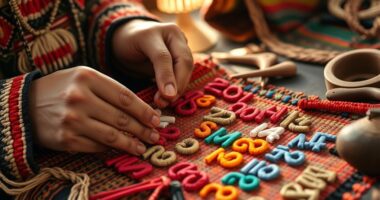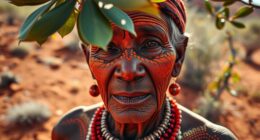Indigenous words like “kangaroo” and “coolamon” are part of everyday language, carrying deep cultural meanings and reflecting Australia’s Aboriginal heritage. These words represent animals, tools, and traditions that connect you to land and community. Using them shows respect and helps preserve important cultural knowledge. Each word tells a story and keeps histories alive, inviting you to explore more about their significance and the rich stories behind them.
Key Takeaways
- Indigenous words like “kangaroo,” “boomerang,” and “coolamon” reveal cultural ties to land, animals, and traditional practices.
- These words embody centuries of Indigenous knowledge, stories, and cultural significance in everyday language.
- Incorporating Indigenous vocabulary promotes respect, awareness, and preservation of Indigenous languages and heritage.
- Many Indigenous terms have survived colonization, highlighting community resilience and ongoing efforts for language revival.
- Using these words honors Indigenous culture, supports cultural connection, and helps keep traditional languages alive for future generations.

Have you ever wondered how many everyday words we use come from Indigenous languages? It’s fascinating to realize that words like “kangaroo,” “boomerang,” and “wallaby” are just a few examples of the rich linguistic heritage passed down from Aboriginal peoples. These words aren’t just vocabulary; they carry deep cultural significance that reflects centuries of connection to the land, animals, and traditions. Recognizing this helps us appreciate the importance of aboriginal language preservation, which is vital for maintaining cultural identity and history. When you use these words, you’re not only describing something familiar but also honoring the stories and knowledge embedded within them. Aboriginal languages serve as living archives, preserving complex relationships with nature and community that have survived through generations. Cost and Budgeting strategies for language revitalization highlight the importance of community involvement and sustained funding efforts.
Many common words like kangaroo and wallaby reflect Indigenous cultural heritage and deep connections to land and tradition.
Many of these words have endured despite centuries of colonization and language suppression. Their survival underscores the resilience of Indigenous communities and highlights the importance of efforts to revive and sustain their languages. By incorporating Indigenous words into everyday speech, you actively contribute to the broader movement of aboriginal language preservation. This isn’t just about vocabulary; it’s about respecting and acknowledging the cultural significance of words that hold meaning far beyond their literal definitions. For example, the word “coolamon,” a traditional carrying vessel, encapsulates Indigenous craftsmanship and the importance of community sharing. When you mention these words, you’re acknowledging the cultural practices and stories they embody, fostering a greater understanding of Indigenous ways of life.
Using Indigenous words in daily conversation also helps challenge misconceptions and promotes cultural awareness. It reminds us that language is a powerful tool for connection and recognition. When you speak or write with awareness of their origins, you help support the ongoing efforts to keep these languages alive. It’s a way of honoring the elders and language keepers who have fought tirelessly to preserve their heritage. Their efforts ensure that future generations can continue to learn about their history and traditions through the words they use.
Incorporating Indigenous words into your vocabulary isn’t just about linguistic interest; it’s a meaningful act of cultural respect. It recognizes the richness and diversity of Indigenous cultures and the importance of safeguarding their languages. Every time you use a word like “kookaburra” or “ute,” you’re helping to keep alive a part of history that might otherwise fade away. In doing so, you contribute to a future where Indigenous languages are celebrated and preserved, ensuring their cultural significance remains vibrant and relevant for generations to come.
Frequently Asked Questions
How Are Indigenous Words Integrated Into Modern Australian English?
You notice Indigenous words are integrated into modern Australian English through language revitalization efforts, which aim to preserve and promote these cultural terms. These words often appear in place names, menus, and educational programs, emphasizing their cultural significance. By doing so, Australians honor Indigenous heritage, keep the language alive, and foster respect for traditional knowledge. This integration helps bridge cultural gaps and enriches everyday conversations with meaningful, authentic expressions.
Do All Indigenous Communities Have Their Own Unique Words?
You might think all Indigenous communities share the same words, but nope, each has its own unique language and dialects. It’s like regional accents—each adds flavor and identity. This diversity highlights the importance of language preservation, because losing one means losing a piece of culture. So yes, every community’s language is special, and keeping them alive is essential to honoring their heritage and uniqueness.
How Can I Learn More Indigenous Words and Pronunciation?
To learn more indigenous words and pronunciation, start by exploring resources for indigenous language, like online dictionaries and language apps. You can also attend community classes or workshops, which offer direct learning and pronunciation tips. Listening to native speakers through videos or audio recordings helps improve your pronunciation. Engage with local indigenous communities respectfully, and ask for guidance—they’re often happy to share their language and traditions with learners.
Are These Words Protected by Cultural Ownership Laws?
You’ll be amazed! These words are often protected by cultural ownership laws that guard Indigenous language rights fiercely, like a treasure chest. While some words are shared freely, many hold deep cultural significance and are legally protected from misuse or misappropriation. Respecting these laws helps preserve the integrity of Indigenous languages and guarantees their rightful owners maintain control. So, always approach with respect, knowing you’re helping uphold a essential cultural legacy.
How Does Using Indigenous Words Promote Cultural Awareness?
Using indigenous words promotes cultural awareness by highlighting their cultural significance and deepening your understanding of Indigenous communities. When you incorporate these words, you help preserve their language and honor their traditions. It fosters respect and connection, showing you value their unique heritage. By actively embracing these words, you contribute to language preservation and create opportunities for meaningful conversations about Indigenous culture and history.
Conclusion
By embracing these Indigenous words for everyday things, you open a window to a rich cultural landscape that’s been here long before us. It’s like adding vibrant colors to a familiar canvas, making your daily life more meaningful and connected. When you use these words, you’re not just communicating—you’re preserving history, honoring tradition, and keeping the heartbeat of Indigenous culture alive. So, let these words be the bridge that links the past and present in your everyday world.
Mary is a passionate writer who brings creativity and a fresh perspective to our team. Her words have the power to captivate and inspire, making her an essential contributor to our content. Mary’s commitment to storytelling and dedication to promoting Indigenous culture ensures that her work touches the hearts of our readers. We’re fortunate to have her as part of our team.









